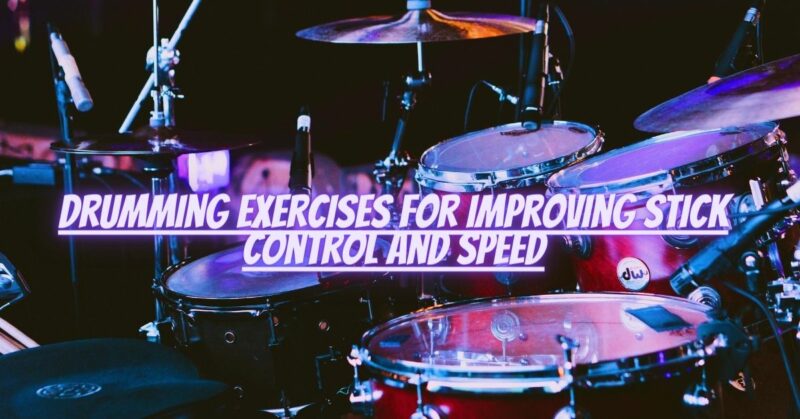Developing solid stick control and speed is essential for drummers looking to enhance their technical proficiency and expressiveness on the drum kit. Whether you’re playing intricate patterns or unleashing lightning-fast fills, having precise stick control and speed allows you to execute your ideas with clarity and finesse. In this article, we will explore a series of drumming exercises designed to improve your stick control and speed, helping you unlock new levels of precision and versatility in your drumming.
- Stick Control Exercises:
- Single Stroke Roll: Start with a slow and controlled single stroke roll, playing alternate strokes on each hand. Gradually increase the tempo while maintaining evenness and consistency in both hands. Focus on achieving a balanced sound and equal volume between the left and right hand strokes.
- Double Stroke Roll: Practice playing controlled double strokes on each hand, starting with a slow tempo and gradually building speed. Pay attention to maintaining a smooth and even sound between the strokes, aiming for clarity and precision.
- Paradiddle: Work on the paradiddle pattern (RLRR LRLL) by playing it slowly at first and gradually increasing the speed. Concentrate on achieving consistent and controlled strokes on each hand while maintaining a steady pulse.
- Rudiments for Speed:
- Single Stroke Four: Play groups of four single strokes (RLLR LRRL) as fast as possible, focusing on keeping the strokes even and maintaining control. Start at a manageable speed and gradually increase the tempo while maintaining accuracy.
- Flam Rudiments: Practice flam rudiments such as flam taps, flam paradiddles, and flam accents. Start at a moderate tempo and gradually build speed, paying attention to maintaining clarity and control between the primary and grace notes.
- Single Stroke Seven: Play groups of seven single strokes (RLLRLRR) at an increased tempo, focusing on maintaining a steady flow and controlled strokes. Work on accenting the first stroke of each group to emphasize the pattern.
- Coordination Exercises:
- Four-Way Coordination: Develop coordination between your hands and feet by practicing various patterns, such as playing a single stroke roll on the snare drum while maintaining a consistent bass drum pattern. Start at a slow tempo and gradually increase the speed, ensuring that all limbs are synchronized and balanced.
- Syncopated Patterns: Practice playing syncopated rhythms, accenting off-beats and syncopated notes while maintaining a steady pulse on the ride cymbal. Experiment with different hand and foot combinations to challenge your coordination and control.
- Technique Building:
- Finger Control Exercises: Work on finger control by playing exercises that emphasize finger control rather than wrist or arm movements. Practice playing rapid singles, doubles, and paradiddles using primarily finger strokes, focusing on precision and speed.
- Moeller Technique: Incorporate the Moeller technique into your practice routine. This technique utilizes a combination of wrist, finger, and arm movements to achieve speed and power. Practice accenting strokes and rebounding off the drumhead to develop control and speed.
- Use a Metronome: Use a metronome or drum machine during your practice sessions to develop a strong sense of time and improve your ability to play with precision and accuracy. Start at a comfortable tempo and gradually increase it as you become more comfortable with the exercises. Concentrate on playing in sync with the metronome, ensuring that your strokes align perfectly with the beats.
Conclusion: Improving stick control and speed is a continuous journey that requires dedicated practice and patience. By incorporating these exercises into your regular practice routine, you can enhance your technical abilities and elevate your drumming to new heights. Remember to start slowly and gradually increase the tempo as your control and speed improve. Regular practice, along with a focus on precision and accuracy, will help you develop the stick control and speed necessary to execute complex drumming patterns, fills, and solos with finesse and confidence. Keep pushing yourself, stay disciplined, and enjoy the process of refining your skills as you become a more accomplished drummer.


